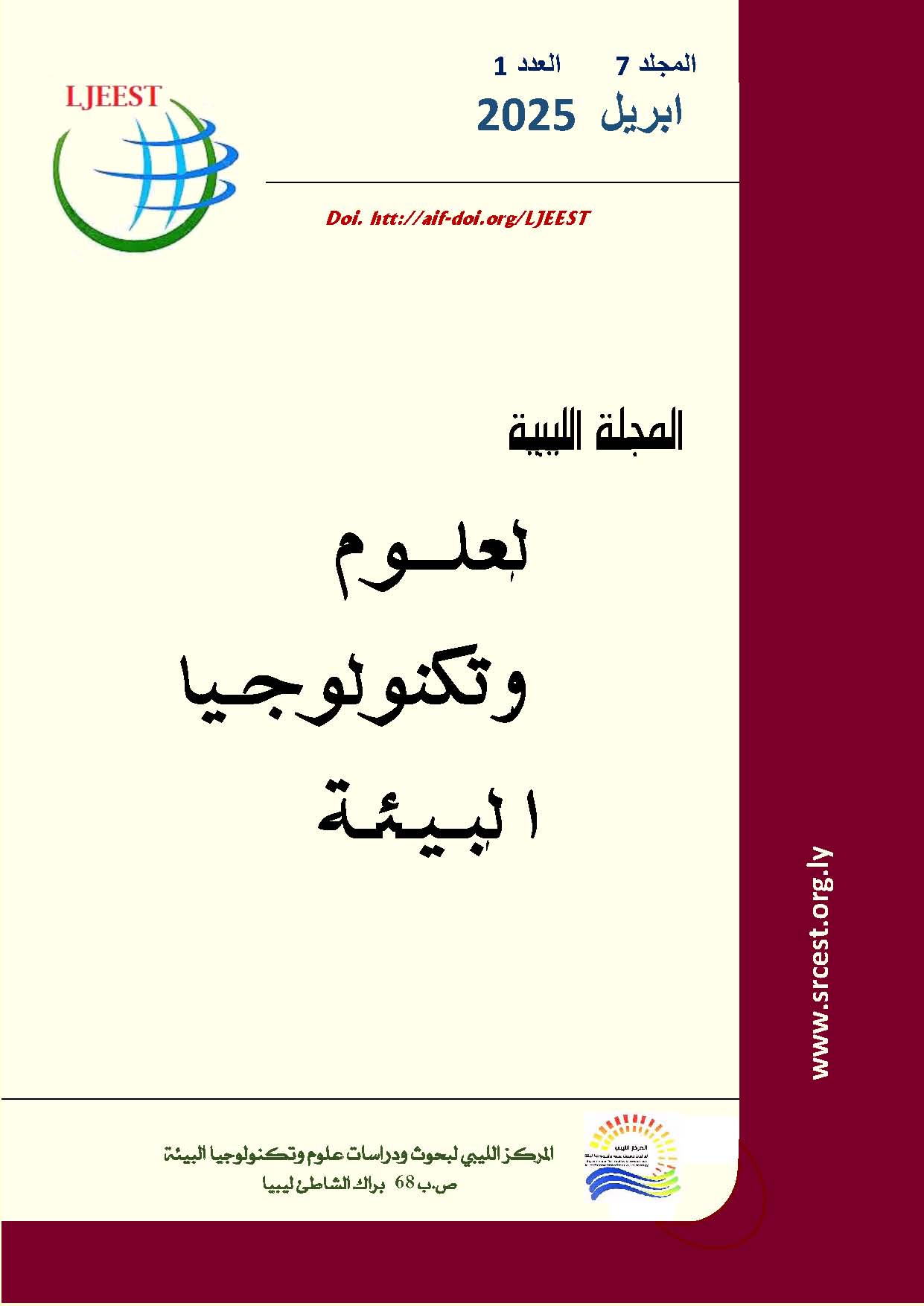أحدث التقنيات في تثبيت التربة باستخدام مخلفات البناء والهدم
DOI:
https://doi.org/10.63359/1cmwbh78الكلمات المفتاحية:
مخلفات البناء، تثبيت التربة، اعادة التدوير، معامل كاليفورنيا التحملالملخص
إن إعادة تدوير النفايات هو نهج وظيفي لتقليل مخزوناتها مع تقديم فوائد اقتصادية وبيئية كبيرة، في الوقت الحاضر تنتج مخلفات البناء والهدم (CDW) كمية كبيرة من النفايات على مدار العام وتتنافس كمواد مضافة قابلة لإعادة الاستخدام عوضاً عن المواد الطبيعية، إن إضافة هذه المواد إلى حبيبات التربة بإيمكانه تحسين الخصائص الجيوتقنية للتربة التي تعاني من مشاكل كما يقلل من التلوث البيئي، العديد من الدراسات أجريت لإعداد وتحسين امكانية إعادة استخدام مخلفات البناء، الورقة الحالية تعرض بعض الدراسات الحديثة التي أجريت حول تطبيق CDW في مجال تثبيت التربة كأداة لتقييم التأثيرات المتوقعة و الناتجة عن استخدام المواد البديلة، الغرض من العمل يكمن في تقييم درجة التحسن لعوامل مقاومة التربة المختلطة مثل نسبة تحمل كاليفورنيا (CBR)، تظهر النتائج التي تم جمعها من الدراسات السابقة أن إعادة تدوير مخلفات البناء (CW) يشكل خطوة أساسية نحو مجتمع أكثر استدامة من خلال تقليل التأثير البيئي الناجم عن التخلص السيئ من هذه المواد في جميع أنحاء العالم، ولمعالجة هذه القضية بشكل جدي، تم تقديم بعض التوصيات للتشجيع على حلول إدارة النفايات المستدامة مثل إعادة الاستخدام وإعادة التدوير، وأخيرا، فإن إعادة تدوير مخلفات البناء من الهياكل التي تم هدمها كمواد أساسية من شأنه أن يساعد في تحقيق الاستدامة الاجتماعية والاقتصادية والبيئية.
المراجع
1. Aboutalebi, Esfahani, M., (2020). Evaluating the feasibility, usability, and strength of recycled construction and demolition waste in base and sub-base courses. Road Materials and Pavement Design, 21(1), 156-178.
2. ACI555R-01, (2001). Removal and reuse of hardened concrete. Reported by ACI committee 555.
3. AECOM (2018) . People’s Republic of China: Construction and Demolition Waste Management and Recycling. Technical Assistance Consultant’s Report. Asia Company Limited for the PRC Ministry of Housing and Urban-Rural Development and the Asian Development Bank
4. Ameta, N.K., Wayal, A.S., & Puneet Hiranandani., (2013). Stabilization of Dune Sand with Ceramic Tile Waste as Admixture. American journal of engineering Research (AJER), 2(9), 133-139.
5. Anand, K. B. G., Agrawel, S., & Dobriyal, A., 2014. Stabilisation of Cohesive Soil Using Demolished Brick Waste. Conference: Innovations and Advances in Civil Engineering Towards Green and Sustainable Systems INACES-2014, At: Coimbatore
6. Arias-Trujillo, J., Matías-Sanchez, A., Cantero, B., & López-Querol, S., (2023). Mechanical stabilization of aeolian sand with ceramic brick waste aggregates. Construction and Building Materials, 363, 129846.
7. Arulrajah, A., Piratheepan, J., & Disfani, M., Bo, M., (2013). Geotechnical and geoenvironmental properties of recycled construction and demolition materials in pavement subbase applications. J.Mater.CivilEng.25, 1077-1088.
8. Ashraf, A., Chukwunonye. E., & Jamal, K., (2016). Estimating construction and demolition (C&D) waste arising in Libya. The 31st International Conference on Solid Waste Technology and Management At: Philadelphia, PA U.S.A. pp 837-849.
9. Binici, H., (2007). Effect of crushed ceramic and basaltic pumice as fine aggregates on concrete mortars properties. Journal of Construction and Building Materials, 21(6), 1191-1197.
10. Bossink, B., & Brouwers H. J. H., (1996). Construction Waste: Quantification and Source Evaluation, Journal of Construction Engineering and Management 122(1), 55-60.
11. Cabalar, A. F., Hassan, D. I., & Abdulnafaa. M. D., (2017). Use of waste ceramic tiles for road pavement subgrade. Road Materials and Pavement Design, 18(4), 882-896.
12. Chen, James A., & Idusuyi, Felix. O., (2015). Effect of Waste Ceramic Dust (WCD) on Index and Engineering Properties of Shrink - Swell Soils. International Journal of Engineering and Modern Technology, 1(8), 52-61.
13. Deboucha, S., MamouneSm, A., Sail, Y., & Ziani, H., (2020). Effects of ceramic waste, marble dust, and cement in pavement Subbase layer. Geotechnical and Geological Engineering, 38: 33313340.
14. Delongui, L., Matuella, M., Núñez, W. P., Fedrigo, W., Silva Filho, L. CP., & Ceratti, J.A.P., (2018). Construction and demolition waste parameters for rational pavement design. Construction & Building Materials Journal, 168, 105-112.
15. Disfani, M. M., Arulrajah, A., Bo, M.W., Hankour, R., (2011). Recycled crushed glass in road work applications, Waste Management journal, 31(11), 2341-2351,
16. EC DG ENV., (2011). European Commission DG ENV. “A project under the Framework contract ENV.G.4/FRA/2008/0112. In: Final Report Task 2-Management of C&D Waste, http://ec.europa.eu/environment/waste/pdf/2011 CDW Report.pdf (last accessedSeptember2014).
17. Eckert, M., & Oliveira, M., (2017). Mitigation of the negative effects of recycled aggregate water absorption in concrete technology. Construction & Building Materials, 133, 416-424.
18. EI-Treiki, J., (2000). The waste disposal in Tripoli are. Libyan Environmental Journal. 6, 30-44. (In Arabic).
19. Fortová, K., & Pavlu, T., (2018). The properties of fine recycled aggregate concrete containing recycled bricks from construction and demolition waste. Key Engineering Materials, 760, 193-198.
20. Gebril, A.O., (2013). Solid Waste Pollution and the Importance of Environmental Planning in Managing and Preserving the Public Environment in Benghazi City and Its Surrounding Areas. International Journal of Environmental, Ecological, Geological and Geophysical Engineering, 3(12), 643-648
21. Gomes Correia, A., Winter, M. G., & Puppala, A. J., (2016). A review of sustainable approaches in transport infrastructure geotechnics. Transportation Geotechnics, 7, 21–28.
22. Hansen, T. C., (1992). Demolition and Reuse of Concrete and Masonry: recycling of demolished concrete, Recycling of masonry rubble, and localized cutting by blasting of concrete. RILEM report 6. E & EN Spon, London.
23. Hemalatha, B.R., Nagendra, P., & Venkata, S.B.V., (2008). Construction and Demolition Waste Recycling for Sustainable Growth and Development. Journal of Environmental Research and Development, 2(4).
24. Henzinger, C., & Heyer, D., (2015). Use of demolition waste in soil improvement. In Geotechnical Engineering for Infrastructure and Development: Conference Proceedings of the XVI ECSMGE, Edinburgh, UK (Winter MG, Smith DM, Eldred PJL and Toll DG (eds)). Thomas Telford, London, UK, pp. 2547-2552.
25. Horpibulsuk, S., Katkan, W., Apichatvullop, A., (2008). An Approach for Assessment of Compaction Curves of Fine Grained Soils at Various Energies Using a One Point Test, Soils and Foundations, 48(1), 115-125.
26. Ibrahim, O. A., Cabalar, A. F., & Abdulnafaa, M. D., (2018). Improving some geotechnical properties of an organic soil using crushed waste concrete. The International Journal of Energy & Engineering Sciences, 3(3)100-112.
27. James, J., & Pandian, P. K., (2015). Effect of phosphogypsum on strength of lime stabilized expansive soil. Građevinar, 66(12), 1109-1116.
28. José, R. J., Jesús, A., Francisco, A., Martín, L., Adela P. G., (2012). Utilisation of unbound recycled aggregates from selected CDW in unpaved rural roads, Resources, Conservation and Recycling, 58, 88-97.
29. Kanniyappan, S., Balakumaran, S., Dhilip-Kumar, R., & Lavanya, C., (2019). Soil Stabilization Using Construction and Demolition, Pramana Research Journal, pp 903-909.
30. Karkush, M. O., & Yassin, S., (2019). Improvement of geotechnical properties of cohesive soil using crushed concrete. Civil Engineering Journal, 5(10), 2110-2119.
31. Koyuncu, H., Guney, Y., Yılmaz, G., Koyuncu, S., & Bakis, R., (2004). Utilization of Ceramic Wastes in the Construction Sector. Key Engineering Materials, 264-268, 2509–2512.
32. Kumar, N., Chetana, C., Khatri, S., & Suman, S., 2019. Use of Brick Dust and Fly Ash as a Soil Stabilizer. Symposium on Recent Advances in Sustainable Geotechnics IGS Kanpur Chapter. C 17-20 October 2019, IIT Kanpur, India.
33. Martinez Lage, I., Martinez Abella, F., Vazquez Herrero, C., & Perez Ordonez, J.L., (2010). Estimation of the annual production and composition of C&D debris in Galicia, Spain. Waste Management, 30 (4), 636-645.
34. Menegaki, M., & Damigos, D., (2018). A review on current situation and challenges of construction and demolition waste management. Curr. Opin. Green Sustain. Chem, 13, 8–15, doi:10.1016/j.cogsc.2018.02.010.
35. Mgboawaji C. U., & Samuel, J. A., 2022. The use of fine portions from construction and demolition waste for expansive soil stabilization: A review. Front. Struct. Civ. Eng., 16(7): 803‒816.
36. Monier, V., Hesstin, M., Impériale, A., Prat, L., Hobbs, G., & Ramos, K.A.M., (2017). Resource efficient use of mixed wastes: Improving management of construction and demolition waste. European Union: Luxembourg, 2017. ISBN: 978‐92‐79‐76478‐3.
37. Ok, B., Sarici, T., Talaslioglu, T., & Yildiz, A. (2020). Geotechnical properties of recycled construction and demolition materials for filling applications. Transportation Geotechnics, 24, 100380.
38. Omran, A., Salahalddin, A.l., & Maria, G., (2011). Municipal solid waste management in Bani Walid city, Libya: practices and challenges. Journal of Environmental Management and Tourism, 2(4), 228-237.
39. Panwar, K., & Ameta, N. K., (2016). Stabilization of fine sand with ceramic tiles waste as admixture for construction of embankment. AJER, 5(8), 206-212.
40. Poon, C. S., Qiao, X. C., & Chan, D., (2006). The cause and influence of selfcementing properties of fine recycled concrete aggregates on the properties of unbound sub-base. Waste management, 26(10), 1166-1172
41. Rahman, M.A., Imteaz, M., Arulrajah, A. & Disfani, M.M., 2014. Suitability of recycled construction and demolition aggregates as alternative pipe backfilling materials. Journal of Cleaner Production, 66, 75-84.
42. Robayo-Salazar, R. A., Valencia-Saavedra, W., Mejía, de., & Gutiérrez, R., (2020). Construction and demolition waste (CDW) recycling-As both binder and aggregates-In alkali-activated materials: A novel reuse concept. Sustainability, 12(14): 5775.
43. Sabat, A. K., (2012). Stabilization of Expansive Soil Using Waste Ceramic Dust. The Electronic Journal of Geotechnical Engineering, 17, 3915- 3926.
44. Saleh, A. A., (2005). The suitability of the Libyan soils for use as engineered landfill liners. PhD Thesis, Loughborough University Institutional Repository.
45. Sangeetha, S.P., Chophi, Z.T., Venkatesh, P., & Fahad, M. (2022). Use of recycled construction and demolition (C&D) wastes in soil stabilization. Nature Environment and Pollution Technology, 21(2), 727–732.
46. Sharma, R. K., (2020). Utilization of fly ash and waste ceramic in improving characteristics of clayey soil: a laboratory study. Geotechnical and Geological Engineering, 38(5), 5327-5340.
47. Shivaprasad, H., & Suresh, Kommu., (2022). Geo technical Laboratory Evaluation of Construction Demolition Recycled Material for Road Embankments . IOP Conference Series: Earth and Environmental Science, (982) 012064.
48. Sri Ravindrarajah, R., & Tam, C. T., (1987). Recycling concrete as fine aggregate in concrete. International Journal of Cement Composites and Lightweight Concrete, 9(4), 235−241.
49. Tong, T., Kien, Le T., Thanh., & Phung, V. Lu., (2013). Utilisation of construction demolition waste as stabilised materials for road base applications. The International Conference on Sustainable Built Environment for Now and the Future. Hanoi, 26 - 27 March 2013 pp 285-293.
50. Townsend, T. G., Jang, Y., & Thurn, L. G., (1999). Simulation of construction and demolition waste leachate. Journal of Environmental Engineering (New York), 125(11), 1071-1081.
51. Vincevica-Gaile, Z., Teppand, T., Kriipsalu, M., Krievans, M., Jani, Y., Klavins, M., Setyobudi, R. H., Grinfelde, I., Rudovica, V., Tamm, T., Shanskiy, M., Saaremae, E., Zekker, I., & Burlakovs, J., (2021). Towards sustainable soil stabilization in peatlands: Secondary raw materials as an alternative. Sustainability, 13, 1–24.
52. Wainwright, P. J., & Cabrera, J. G., (1994). Use of demolition concrete to produce durable structural concrete. Studies in Environmental Science, 60, 553-562.
التنزيلات
منشور
إصدار
القسم
الرخصة
الحقوق الفكرية (c) 2025 المجلة الليبية لعلوم وتكنولوجيا البيئة (LJEEST)

هذا العمل مرخص بموجب Creative Commons Attribution-NonCommercial 4.0 International License.














